Finland provides many good examples of how to protect the natural environment. Wide-ranging and detailed environmental data and high levels of technological skill form the basis of Finland’s effective environmental protection policies. As one of the world’s wealthiest industrialised countries Finland is also able to afford vital environmental investments. Finland’s low population density and comparatively unspoilt natural environment also facilitate nature conservation.
The fruits of successful environmental policies are clearly visible around the country. Many polluted lakes and rivers have been cleaned up. Air quality has improved greatly around industrial locations. An extensive network of protected areas has been built up to safeguard biodiversity. Forests – Finland’s most valuable natural resources – are managed more sensitively than in the past, and the overall annual growth rate clearly exceeds the total timber harvest.
Emissions from large industrial facilities have particularly been curbed significantly. There has also been progress in controlling emissions from agriculture, transport and homes, although these trends have not been as favourable as for industry. There is still a need to reduce airborne emissions of carbon dioxide, noise and particles from traffic, as well as waterborne nutrient emissions generated by farms and by scattered settlements not connected to sewerage systems.
Efforts to halt the ongoing decline in biodiversity have also been insufficient in spite of progress in the conservation of certain threatened species. The struggle to combat climate change must also be continued more resolutely both in Finland and globally. But the successful reduction of acidification problems shows that well-planned strategic environmental policies can achieve their goals.
Sensitive northern environments
The main aim of environmental protection is to anticipate risks and prevent damage before any harm is done. It is especially vital to be aware of critical ecological thresholds in cold northern environments, where nature can be slow to recover from any damage.
The vegetation of Finnish Lapland is especially sensitive to disturbances such as logging and overgrazing by domesticated reindeer. Fortunately these threats have been reduced through the protection of large areas of forest and restrictions on the number of reindeer. Increasing tourism in Lapland can likewise burden the environment, but it can also encourage environmental protection, since most tourists are attracted to Lapland by the region’s unspoilt natural settings.
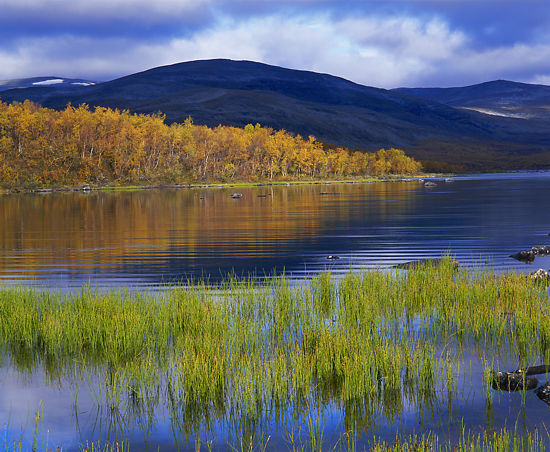
Tourism in Lappland can burden the environment but it can also encourage environmental protection, since tourists are attracted to Lapland by the unspoilt nature.Photo: Finnish Tourist Board/Pekka Luukkola

Photo: Finnish Tourist Board
It is much harder and more expensive to repair any damage done to the environment than to prevent harm in the first place. In the worst cases damage may even be irreparable. Arctic climatic conditions may inhibit the natural regeneration of logged forests in northern Lapland. On the other hand, the predicted warming of the climate could completely wipe out species and whole ecosystems adapted to cold conditions.
Climate change and the consequent reduction in snow and ice cover could prove to be fateful for animals such as the Saimaa ringed seal, since these rare lake seals raise their young in winter dens dug in compact snowdrifts on the frozen waters of the Saimaa lake system in eastern Finland. Thanks to the efforts of conservationists, seal numbers have risen slowly since the 1980s, but there are still fewer than 300 seals, and their population increase seems to be slowing. Saimaa ringed seals used to face problems including persecution by fishermen and contamination with mercury and other toxic chemicals. Controls over fishing have thankfully reduced the numbers of young seals killed in fishing nets or traps, but seals are increasingly suffering due to the disturbance of their habitat by snowmobile traffic in the winter, and the construction of lakeside holiday homes.
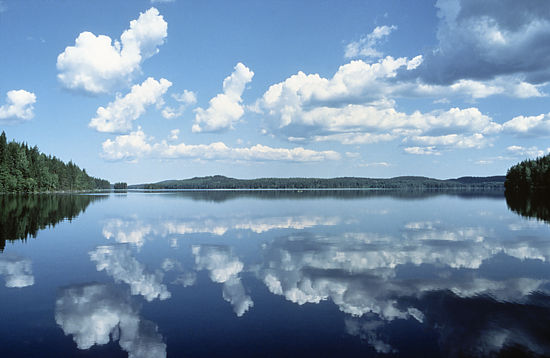
Across 80% of Finland’s lacustrine area the water is rated excellent or good. Water near industrial sites has improved but Finland’s inland waters are shallow and vulnerable and thus still need care.Photo: Finnish Tourist Board
Many environmental problems can be lessened if sufficient time and money can be found to address them. But it could take decades to resolve the problem of eutrophication in Finland’s inland waters and the Baltic Sea, for instance. Over time some waters could recover from the presence of excess nutrients through natural processes, if further inputs of phosphorus and nitrogen could be kept down to acceptable levels. But there are at least 1,500 lakes around Finland where more active ecological restoration measures such as selective fishing, oxygenation or the removal of aquatic vegetation would be needed to combat eutrophication effectively. Such measures have already been applied in almost a thousand lakes.
Eutrophication is an example of a gradual environmental change that can suddenly attract the attention of the public when a certain threshold is exceeded. In Finland eutrophication first became the focus of extensive debate in the summer of 1997, when massive algal blooms occurred widely in the Gulf of Finland. Blue-green algae occur naturally in Finnish waters, but such massive blooms are a clearly visible consequence of decades of excessive nutrient loads.
Water quality is classified as excellent or good across 80% of the total area of Finland’s lakes. Waters near industrial facilities have particularly become cleaner in recent years. But Finland’s small and shallow bodies of water are sensitive to pollution, and environmental protection must still be further enhanced.
Finnish track record
Finland has been rated among the world’s leading countries in many international comparisons of environmental protection standards, such as the Global Economic Forum’s regularly compiled Environmental Sustainability Index. Finland’s strengths include highly effective environmental administration and legislation, and the ways environmental protection is considered in all sectors of society.
But not all comparisons are so flattering. Signs of the need for improvement include Finland’s large ecological footprint, high levels of material and energy consumption, and excessive greenhouse gas emissions.
The WWF assesses the environmental impacts of societies or individuals through indicators known as ecological footprints, which show how much biologically productive space would be needed to meet our levels of consumption and deal with the wastes and emissions we generate. A recent comparative study revealed Finland’s natural resource consumption rates per capita to be the third highest in the world.

Finland is Europe’s most forested country, with more than 70% of the land covered with forests. About 17,000 km2 of forest is strictly protected. Finland’s forest resources are increasing as the natural growth of forests more than compensates for the amounts of timber logged.Photo: Ponsse
According to the WWF, the average Finnish citizen has an ecological footprint of about 7.6 global hectares. This footprint is more than three times larger than the global average. Finland does have more than 12 global hectares of biologically productive areas per head of population, however, which is much higher figure than the national consumption rate. This figure is so high due to Finland’s extensive areas of sparsely populated forest.
The environmental loads produced by Finns are also large in absolute terms. When all the natural resources used in Finland are added up to give the country’s Total Material Requirement (TMR), it becomes evident that each person consumes an average of about 100 tonnes of resources every year. This figure includes the hidden material flows that lie behind the production of all goods and services. These figures are high due to Finland’s high standard of living, large-scale intensive metal and forest industries, and the high demand for energy due to the cold climate and long distances.
Enhancing the efficiency of the use of materials is one of the main goals of today’s environmental policies. The concept of eco-efficiency is used to promote such improvements, with the idea being to produce more commodities and well-being using the same amounts of resources. Initiatives designed to increase eco-efficiency include a wide-ranging national programme to promote sustainable consumption and production launched in 2005. This programme includes more than 70 measures designed to save energy and natural resources. Such goals can only be reached through the active involvement of all sectors of society.
The Baltic Sea – permanently ill?
Some experts fear that the state of the Baltic Sea has deteriorated so much that it might never be able to revert to its natural condition. The Baltic is a shallow sea, and has only a slow exchange of water with the open seas. In its catchment area live 5.2 million Finns and some 80 million other people and much of the pollution from their homes, workplaces, farms and ships ends up in the sea. Symptoms of the Baltic’s serious ecological problems include mass algal blooms, declining fish stocks and extensive lifeless areas on the sea bed.
The depletion of vital oxygen from large areas of the seafloor is a consequence of the high inputs of nutrients entering the Baltic. Oxygen is used up when algae and other organic matter sink to the sea bed and decompose. In the absence of oxygen, large quantities of phosphorus can be released from seafloor sediments into the water. This internal nutrient loading can prolong the eutrophication process even where new inputs of nutrients from the land are kept under control.
The bottom waters of the Baltic are only replaced effectively when an occasional major pulse of heavy salty water from the North Sea flows in along the sea bed through the Danish Straits. In recent decades such pulses have been increasingly rare. It is not yet known whether this is a natural variation, or the impact of climate change on sea currents.

The waters of the Gulf of Finland near Helsinki are much cleaner than they used to be, thanks to successful environmental protection work. But to improve the state of the whole Gulf, measures need to be taken in Russia and Estonia as well as Finland.Photo: Martti Lintunen
Nutrient emissions from Finland’s coastal towns and fish farms into the Baltic have declined significantly. Finland has also contributed to improvements in wastewater treatment in the Russian city of St Petersburg, which represents the largest single source of nutrient loads entering the Gulf of Finland. Cleaning up St Petersburg’s wastewater is the fastest way to improve the state of the Gulf.
The condition of the Baltic Sea has long worried citizens and politicians from all the countries around its shores. One of the first ever international environmental agreements, the Helsinki Convention on the protection of the Baltic marine environment was signed by the coastal states in 1974. The Helsinki Commission (HELCOM) was set up to co-ordinate both the implementation of the convention and related improvements in environmental protection around the Baltic Sea.
Thanks to national and international actions, the amounts of toxic chemicals entering the Baltic Sea have been radically reduced. Many of the coastal states have also curbed nutrient inputs. More than half of the worst pollution sources around the Baltic have already been successfully addressed, enabling them to be removed from HELCOM’s Hot Spots List. Only one of the originally listed ten Finnish hot spots remains: farmland in southwest Finland bordering the Archipelago Sea.
Green and spacious cities
By international standards Finland’s cities are small and blessed with many green areas. Most have only grown recently and are still developing rapidly. Until the mid 20th century Finland was still largely a rural society. Large-scale industrialisation only commenced after the Second World War. The new demand for an industrial labour force and the mechanisation of agriculture led to rapid urbanisation, especially from the 1960s onwards. Migration trends in recent years have involved the movement of people from smaller towns to a handful of larger urban centres.
This migration and rapid construction have resulted in more spatially scattered suburban communities, especially on the fringes of larger cities. This trend is problematic in environmental terms, as it leads to increases in traffic, energy consumption and the use of natural resources. It is difficult to organise effective public transportation systems where homes, services and workplaces are scattered over large areas. Planners nowadays endeavour to locate new buildings in existing built-up areas near the necessary infrastructure. Well-planned urban developments can still leave enough room for green areas and nature.
Air pollution and other environmental problems associated with cities around the world are comparatively slight in Finland’s urban centres. The most serious health problems concern particle emissions and noise. More than 800,000 Finns live in surroundings where they are subjected to noise levels of more than 55 decibels. Road traffic is the main source of this acoustic pollution , which can be difficult to reduce since residential areas are necessarily located near road links.
Airborne particle emissions reduce urban air quality in Finland particularly in the springtime, when the dry air can contain high concentrations of particles eroded from roads by the studded winter tyres of vehicles and the grit spread on roads through the winter to prevent skidding. This problem is serious enough to provoke widespread public concern. Particles emitted from domestic heating systems are also a health risk, especially in areas where many homes are heated with firewood.
Climate change and energy
Global climate change is expected to have extremely dramatic effects in Finland. Finnish experts have estimated that mean annual temperatures could rise by 2–7oC by 2080, while annual precipitation could increase by 5–40%. The winters could become largely snow-free in southern Finland, whilst in the north more snow may fall than previously.
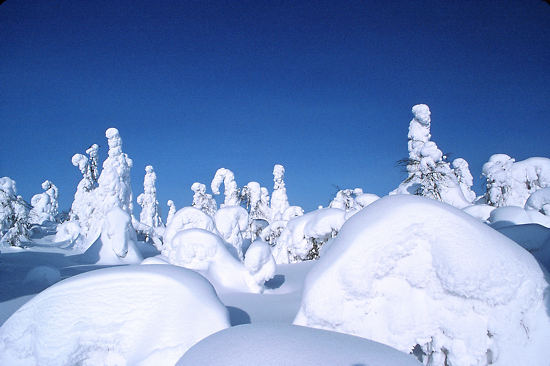
Climate change could mean largely snow-free winters in southern Finland, whilst in the north more snow may fall than previously.Photo: Finnish Tourist Board/Hannu Hautala
Finland’s contributions to global greenhouse gas emissions are small in absolute terms, but very high when measured per capita. It is proving to be very difficult to reduce emissions to their 1990 level, which has been set as Finland’s target under the UN Kyoto Protocol. Emission levels in recent years have clearly exceeded this target, except during a couple of years with exceptional conditions.
Finland’s northerly location increases the demand for energy and natural resources, but the cold climate has also forced people to make sure that they produce and use energy efficiently, and insulate their homes well. Finland is one of the world’s leading countries in co-generation, the production of combined heat and power (CHP), by which the same power plant produces both electricity for the local grid, and heat to warm buildings and run industrial processes, a system known as district heating. This makes good use of heat energy that would be wasted in facilities only generating electricity.
Renewable energy sources account for about a quarter of all the energy used in Finland – a very high proportion by international standards. A large part of this renewable energy is produced from residuals generated in the pulp and paper industry, including bio-sludge and wood chips. Almost half of the wood used in Finland is burnt to produce energy.

Chart of energy sources in Finland 1996-2006.
About 50 per cent of Finland’s energy is produced by burning oil, gas or coal. Nuclear power accounts for 16% of the country’s energy, and peat about 5%. The share of nuclear energy will rise in a few years when Finland’s fifth nuclear reactor comes into operation.
Finland’s energy policies aim to significantly increase the use of renewable energy sources. So far wind power, solar power and geothermal or ground source heat are only exploited on a very small scale, but the number of Finnish buildings warmed using ground source heat is increasing rapidly. The greatest challenge for Finland is to find ways to save energy more effectively.
Threat of acidification receding
Measures taken to combat acidification represent one of the most significant successes in the field of environmental protection. Purposeful policies followed at national and international level have had the desired effects. Finland’s soils are naturally vulnerable to acidification, since they only contain low concentrations of calcium to buffer the acidifying effects of sulphur and nitrogen compounds deposited in the soils from airborne pollution. Farmland soils in Finland have to be regularly limed due to their natural acidity.
Thanks to various international environmental agreements and the development of cleaner fuels and emission cleaning technologies, acidifying emissions have declined steeply around Europe. And the collapse of the Soviet Union reduced airborne acidifying emissions from beyond Finland’s eastern border. Finland’s own atmospheric sulphur and nitrogen emissions are today just 25% and 60% of their levels in 1990.
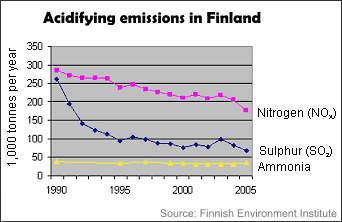
Chart of acidifying emissions in Finland.
Acidification is harmful to many plants, but especially aquatic species. The forests and inland waters of northern Finland are particularly vulnerable, since their buffering capacity is naturally weak. Habitats in southern Finland are generally more resistant to acidification.
The harmful impacts of acidifying compounds can be expressed in terms of critical loads, which are the highest concentrations of impurities that an ecosystem can withstand without significant damage. If this critical load is exceeded, the entire functioning of an ecosystem can be endangered. According to such indicators the threat of acidification generally seems to be receding in Finland.
Toxic chemicals
Unnatural concentrations of toxic chemicals in the environment have given rise to public concern, but their levels in Finland do not currently represent a serious health risk. Emissions of the most hazardous substances have been significantly reduced. Annual atmospheric emissions of lead, for instance, have declined from more than 1,000 tonnes in the early 1980s to just 20 tonnes today. Finland does not suffer from large quantities of airborne toxic pollution originating from other countries.
Finland’s winters are too cold for many crop pests to survive, so farmers do not need to use as many pesticides as their counterparts further south. But in such harsh conditions even small quantities of hazardous substances can be fateful for sensitive ecosystems and the cold climate can slow the natural degradation of toxic substances.
Only a few chemicals have been studied in enough detail for comprehensive evaluations of their environmental impacts to be possible. The EU’s REACH Regulation system (for the Registration, Evaluation and Authorisation of Chemicals) aims to improve the management of risks related to chemicals. A key element of this system will be a database maintained by the new European Chemicals Agency, located in Helsinki. The database will include a register of all substances manufactured or imported by EU countries in quantities of more than one tonne. It has been estimated that the system will cover some 30,000 chemicals.
It is important to have comprehensive information about the properties of different chemicals, to ensure that action is taken to prevent releases of the more harmful chemicals into the natural environment. Preventive measures are vital, since many hazardous substances persist in the environment indefinitely, or only degrade slowly. Chemicals contaminating soils can still cause problems decades after the pollution occurs. In Finland there are estimated to be approximately 20,000 sites potentially suffering from soil contamination. Efforts to remediate such sites intensified in the late 1990s, and more recently clean-up work has been initiated at several hundred sites annually.
Biodiversity in Finland
Finland’s biodiversity is exceptionally well documented, thanks to high quality research and the work of many keen amateur naturalists. On the other hand, Finland’s natural habitats contain fewer species than other habitats such as tropical rainforests. It is estimated that some 42,000 species occur naturally in the wild in Finland but in spite of the dedicated work of researchers, sufficient information is only available for the conservation statuses of about 15,000 of these species to be evaluated. About a tenth of these evaluated species have been classified as threatened. Some 200 species have provenly become extinct in Finland.
Finland and the other EU countries officially aim to halt the ongoing decline in biodiversity by 2010, but this goal is unlikely to be achieved. The number of threatened species in Finland is expected to grow by about 10% by 2010.
Most of Finland’s threatened species are associated with forest and farmland habitats. Forest species are threatened by logging and the shortage of decaying wood in commercially managed forests, and by the fragmentation of the remaining natural forests. Meanwhile, due to the intensification of agriculture, small-scale ecologically diverse habitats created by traditional farming practices have almost disappeared from the Finnish countryside. The spread of building developments along shorelines also reduces biodiversity.
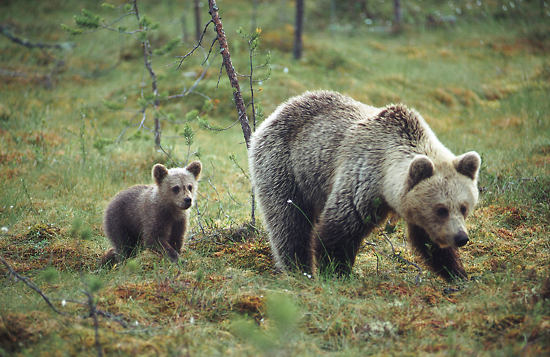
The number of Finland’s large carnivores, bear, lynx, wolf and wolverine, has increased in recent years.Photo: Finnish Tourist Board/Eero Kemilä
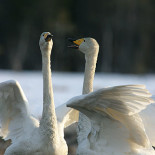
Finland’s national bird, the whooper swan, has also become more widespread since the end of the 1950s.Photo: Finnish Tourist Board
Finland has achieved notable nature conservation successes in recent years, particularly in the cases of some larger animals and birds that were formerly hunted or harassed. Finland’s national bird, the whooper swan, for instance, has become much more widespread in recent decades.
The growing numbers of Finland’s four large carnivores – bear, lynx, wolf and wolverine – have provoked widespread public debate. These predators are feared in rural areas, even though exceptional permits have always been readily granted for the hunting of individual animals considered to be dangerous. There has been less controversy about increasing numbers of golden and white-tailed eagles.
Invasive species are one of the greatest threats to biodiversity around the world. The rapid spread of exotic species can seriously disrupt native ecosystems. So far only a few such species have created problems in Finland. The cold climate offers some protection, as many invaders fail to survive the northern winter. Biodiversity in Finland could be faced by many more problems with invasive species if the climate becomes warmer.
Jari Lyytimäki, M.Sc., researcher, Finnish Environment Institute, July 2007, updated July 2014



